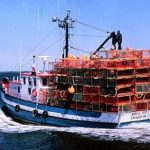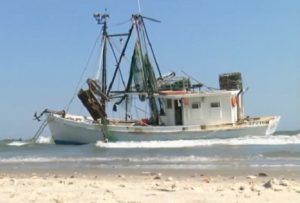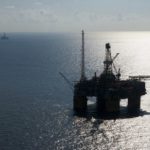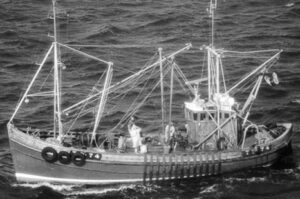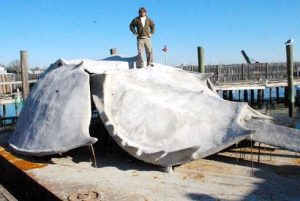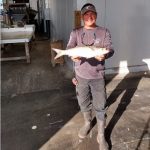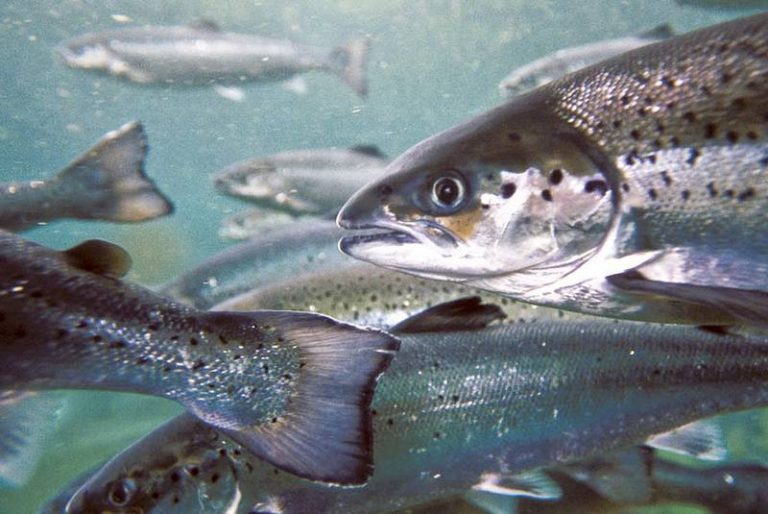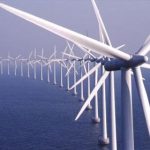Tag Archives: Chesapeake Bay
Will a great year for Chesapeake Bay crabs mean a great year for Watermen?
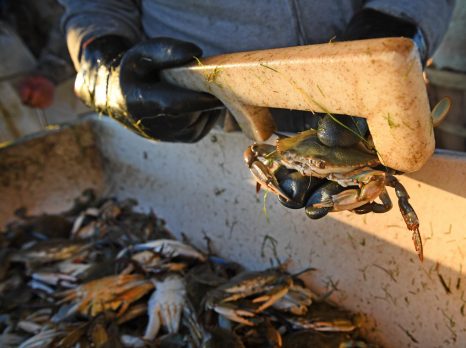 At 4:41 a.m., Bubby Powley looked at his watch, looked at the thin, pink glow to the east, and looked at the dark water sliding past his boat. According to Maryland state law, he was allowed to start catching crabs exactly one hour before sunrise, and that was right . . . about . . . “Now. Dontcha think, Monroe?” Powley said, hitting a lever on a boom that lifted his first batch of the day from the Chesapeake Bay. The sprightly 66-year-old swung the basket inboard, where his culler of 42 years, Monroe Dorsey, 68, a slim cigar clenched under his white mustache, dumped a few dozen wriggling crustaceans into a fiberglass basin. It was a pretty good haul in what so far has been a very good crab harvest. Dorsey measured male after male with a plastic caliper and tossed those of five inches or more into one of the six and a half bushels Powley would sell later that day to a wholesaler. The summer is getting off to a promising start along America’s biggest estuary,,, Read the rest here 15:31
At 4:41 a.m., Bubby Powley looked at his watch, looked at the thin, pink glow to the east, and looked at the dark water sliding past his boat. According to Maryland state law, he was allowed to start catching crabs exactly one hour before sunrise, and that was right . . . about . . . “Now. Dontcha think, Monroe?” Powley said, hitting a lever on a boom that lifted his first batch of the day from the Chesapeake Bay. The sprightly 66-year-old swung the basket inboard, where his culler of 42 years, Monroe Dorsey, 68, a slim cigar clenched under his white mustache, dumped a few dozen wriggling crustaceans into a fiberglass basin. It was a pretty good haul in what so far has been a very good crab harvest. Dorsey measured male after male with a plastic caliper and tossed those of five inches or more into one of the six and a half bushels Powley would sell later that day to a wholesaler. The summer is getting off to a promising start along America’s biggest estuary,,, Read the rest here 15:31
Smithsonian expert urges caution, patience on blue crab recovery
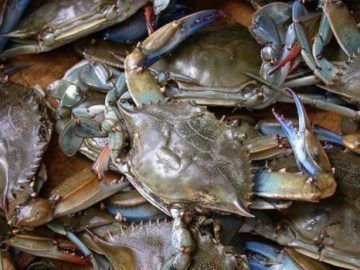 The results are in, 2016 is going to be a good year for blue crabs in the Chesapeake Bay. An iconic figure embedded in the culture and cuisine of the Chesapeake Bay area, the blue crab (Callinectes sapidus) sustains the most profitable fishery in Maryland and supports thousands of fishermen and seafood businesses in Maryland and Virginia. Based on the annual winter survey conducted by the Maryland Department of Natural Resources and the Virginia Institute of Marine Science, there are nearly 35 percent more blue crabs in the Chesapeake Bay this season than there were in 2015. That’s good news, especially on the heels of a 38 percent increase the previous year. But scientists say there is a cautionary tale in this rapid rise. (but, of course!) Read the rest here 16:29
The results are in, 2016 is going to be a good year for blue crabs in the Chesapeake Bay. An iconic figure embedded in the culture and cuisine of the Chesapeake Bay area, the blue crab (Callinectes sapidus) sustains the most profitable fishery in Maryland and supports thousands of fishermen and seafood businesses in Maryland and Virginia. Based on the annual winter survey conducted by the Maryland Department of Natural Resources and the Virginia Institute of Marine Science, there are nearly 35 percent more blue crabs in the Chesapeake Bay this season than there were in 2015. That’s good news, especially on the heels of a 38 percent increase the previous year. But scientists say there is a cautionary tale in this rapid rise. (but, of course!) Read the rest here 16:29
Maryland scientists to conduct Chesapeake Bay oyster harvest study
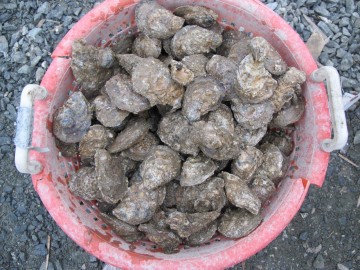 Scientists say they have only a vague idea of how many oysters cover the reefs in the Chesapeake Bay, and can’t say how many can be harvested safely each year without threatening the future of an already decimated population.In the waning hours of its 2016 session, the Maryland General Assembly this week authorized a study that advocates say will not only provide a more precise count of the bivalves, but assess how quickly they are reproducing, how fast they are growing and how they are faring against disease. The oyster study stoked controversy in an hours-long hearing earlier this month. Many watermen said it would lead inevitably to restrictions on their harvests, and the state Department of Natural Resources initially opposed it because the legislation left the DNR out of the research. But in a compromise, lawmakers gave the department responsibility for the study, to be conducted by researchers at the University of Maryland Center for Environmental Science. A final report is due in December 2018. Read the rest here 19:12
Scientists say they have only a vague idea of how many oysters cover the reefs in the Chesapeake Bay, and can’t say how many can be harvested safely each year without threatening the future of an already decimated population.In the waning hours of its 2016 session, the Maryland General Assembly this week authorized a study that advocates say will not only provide a more precise count of the bivalves, but assess how quickly they are reproducing, how fast they are growing and how they are faring against disease. The oyster study stoked controversy in an hours-long hearing earlier this month. Many watermen said it would lead inevitably to restrictions on their harvests, and the state Department of Natural Resources initially opposed it because the legislation left the DNR out of the research. But in a compromise, lawmakers gave the department responsibility for the study, to be conducted by researchers at the University of Maryland Center for Environmental Science. A final report is due in December 2018. Read the rest here 19:12
Tangier Island Is Sinking. Its Population Is Shrinking. And These Guys Want to Make It the Oyster Capital of the East Coast
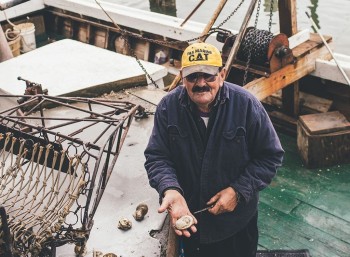 The water is 54 degrees, cold enough that Craig Suro lets out a yelp when he dives in. Stinging sea nettles the size of Ping-Pong balls dot the surface around him. To make matters worse, Suro needs to go to the bathroom. “Can you piss in a wetsuit?” he asks. We’re floating a few hundred yards off Tangier Island, a speck of land in the Chesapeake Bay. Beneath us is some of the bay’s finest oyster-growing territory. Its waters are salty but not too salty, a moderate 17 parts per thousand. Enough algae is borne on the currents for millions of oysters to gorge themselves happily. Suro and his partners have bet half a million dollars on being able to turn this patch of bay into an oyster-farming empire. Read the rest here 10:28
The water is 54 degrees, cold enough that Craig Suro lets out a yelp when he dives in. Stinging sea nettles the size of Ping-Pong balls dot the surface around him. To make matters worse, Suro needs to go to the bathroom. “Can you piss in a wetsuit?” he asks. We’re floating a few hundred yards off Tangier Island, a speck of land in the Chesapeake Bay. Beneath us is some of the bay’s finest oyster-growing territory. Its waters are salty but not too salty, a moderate 17 parts per thousand. Enough algae is borne on the currents for millions of oysters to gorge themselves happily. Suro and his partners have bet half a million dollars on being able to turn this patch of bay into an oyster-farming empire. Read the rest here 10:28
Fishermen encouraged to take big bite out of Bay’s blue catfish population
 For years, Rocky Rice made his living primarily by fishing two of the Bay’s most iconic species: striped bass in the spring and blue crabs much of the summer. But after several years of poor blue crab catches, and with new catch limits on striped bass being put in place, Rice added one of the Bay’s most troublesome species to his mix: blue catfish. Rice is one of a growing number of fishermen responding to the plea of fishery officials to catch as many of the voracious predators as they can. Read the rest here 17:07
For years, Rocky Rice made his living primarily by fishing two of the Bay’s most iconic species: striped bass in the spring and blue crabs much of the summer. But after several years of poor blue crab catches, and with new catch limits on striped bass being put in place, Rice added one of the Bay’s most troublesome species to his mix: blue catfish. Rice is one of a growing number of fishermen responding to the plea of fishery officials to catch as many of the voracious predators as they can. Read the rest here 17:07
Chesapeake crabbers face changing workforce, murky future
Morgan Tolley is a third generation crab processor working on the shores of the Chesapeake Bay, but he’s worried that his industry may be under threat as more and more young people shun the traditional family-oriented trade. The A.E. Phillips crab picking house Tolley manages in Fishing Creek, Maryland, relies on crabs harvested by the “watermen” of the Bay. “It’s passed down from generation to generation, that’s how you learn to become a waterman. Not everybody knows how to fish a trotline or bait a crab pot,” Tolley said. Read the rest here 13:08
The real culprit behind the war on watermen is pollution
 The Maryland Department of Natural Resources (DNR) has been accused of waging a “war on watermen,” and watermen are fighting back, seeking changes in the way the bay’s fisheries are being managed. They say their livelihoods are being undermined and their culture threatened. They are right about that, but they are directing their anger at the wrong people. The bay is choking on an overload of nitrogen, phosphorus and sediment from a variety of pollution sources. The results of this over-enrichment are massive population explosions of algae that turn the water to pea soup from spring to fall. This cloudy water blocks sunlight from underwater grasses, reducing this critical habitat for crabs and juvenile fish to only 20 percent of historical coverage. Read the rest here 15:27
The Maryland Department of Natural Resources (DNR) has been accused of waging a “war on watermen,” and watermen are fighting back, seeking changes in the way the bay’s fisheries are being managed. They say their livelihoods are being undermined and their culture threatened. They are right about that, but they are directing their anger at the wrong people. The bay is choking on an overload of nitrogen, phosphorus and sediment from a variety of pollution sources. The results of this over-enrichment are massive population explosions of algae that turn the water to pea soup from spring to fall. This cloudy water blocks sunlight from underwater grasses, reducing this critical habitat for crabs and juvenile fish to only 20 percent of historical coverage. Read the rest here 15:27
A great migration is under way – Spring brings fish by the millions to Chesapeake Bay
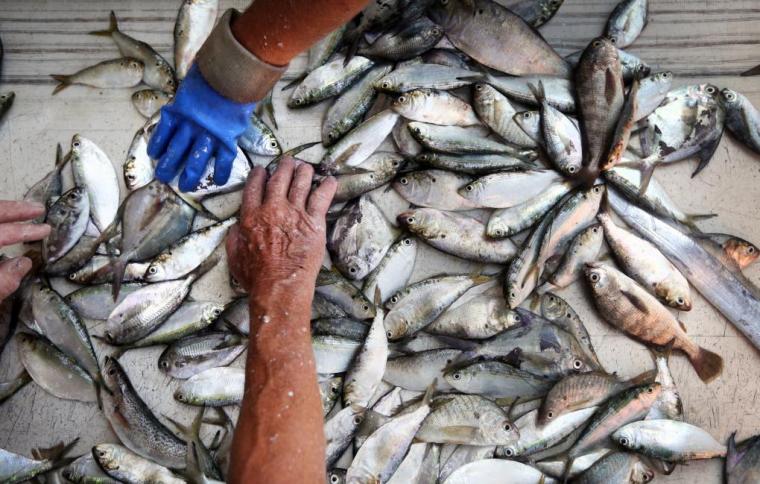 Tourists aren’t the only ones flocking to our waters this time of year. A great migration is under way beneath the surface, too. Triggered by warming seas, hidden by tea-colored waves, propelled by the hunt for food and sheltered nursery grounds, all sorts of creatures are swimming or crawling their way up from the south. Their destination: the Chesapeake Bay. In the winter, only 30 or so aquatic species ply the bay. In the summer, that number explodes beyond 250.The catch flooding into the Lynnhaven Fishing Company tells the tale of the seasonal commute, Read the rest here 08:56
Tourists aren’t the only ones flocking to our waters this time of year. A great migration is under way beneath the surface, too. Triggered by warming seas, hidden by tea-colored waves, propelled by the hunt for food and sheltered nursery grounds, all sorts of creatures are swimming or crawling their way up from the south. Their destination: the Chesapeake Bay. In the winter, only 30 or so aquatic species ply the bay. In the summer, that number explodes beyond 250.The catch flooding into the Lynnhaven Fishing Company tells the tale of the seasonal commute, Read the rest here 08:56
Mathematicians and Blue Crabs
 Scientists in the Chesapeake Bay area have been playing a real-life version of Valentine’s game, with blue crabs instead of grouse. Each spring, they wait for the results of the baywide Blue Crab Winter Dredge Survey, the most recent of which were announced Monday. The estimate of the crab population gives scientists another data point to work with, and anxious watermen a sense of whether this will be a good or bad year for the most valuable commodity in the Chesapeake. Read the rest here 09:29
Scientists in the Chesapeake Bay area have been playing a real-life version of Valentine’s game, with blue crabs instead of grouse. Each spring, they wait for the results of the baywide Blue Crab Winter Dredge Survey, the most recent of which were announced Monday. The estimate of the crab population gives scientists another data point to work with, and anxious watermen a sense of whether this will be a good or bad year for the most valuable commodity in the Chesapeake. Read the rest here 09:29
Survey shows number of blue crabs in Chesapeake Bay rising
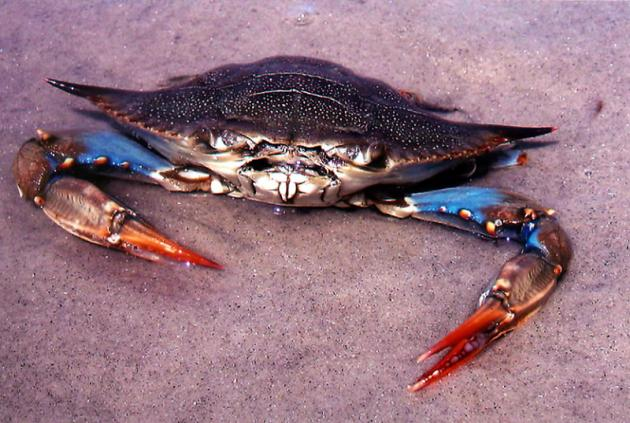 An annual survey by marine officials shows a significant increase in the number of blue crabs in the Chesapeake Bay. The Virginia Marine Resources Commission says the overall bay-wide crab population increased from 297 million crabs to 411 million crabs, a 38 percent increase. The long, cold winter kept the numbers from being higher. The survey shows about 28 percent of all adult crabs in Maryland died due to the cold weather. Read the rest here 16:25
An annual survey by marine officials shows a significant increase in the number of blue crabs in the Chesapeake Bay. The Virginia Marine Resources Commission says the overall bay-wide crab population increased from 297 million crabs to 411 million crabs, a 38 percent increase. The long, cold winter kept the numbers from being higher. The survey shows about 28 percent of all adult crabs in Maryland died due to the cold weather. Read the rest here 16:25
Oyster poaching continues on bay despite enforcement efforts

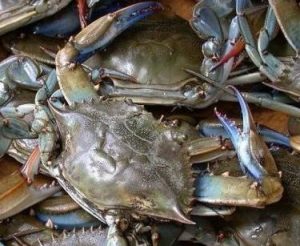
Chesapeake Bay’s blue crab population rebounding
Last year was a dismal episode for Chesapeake Bay blue crabs and the watermen who harvest them. It’s not that crabs were being overfished. Instead, experts suspect a combination of environmental factors. The good news now is that preliminary evidence from the annual blue crab winter dredge survey shows the numbers are climbing again. Read the rest here 08:26
PHAs: ‘Bacteria fat’ that can help us save the Chesapeake – Crab Pot’s, and Shotgun Wads
 PHAs are plastics that are made by bacteria. PHAs also are eaten by bacteria. “It’s like fat,” Kirk Havens says. He explained that just as vertebrates store energy in fat deposits, many bacteria synthesize PHAs—short for polyhydroxalkanoates—to store carbon and energy. An individual bacterium will draw on its little dab of polymer reserve to get through the lean days in its microscopic world, unless a bigger microorganism eats it first. Anything made of PHA will biodegrade, simply because bacteria start eating it. Read the rest here 11:53
PHAs are plastics that are made by bacteria. PHAs also are eaten by bacteria. “It’s like fat,” Kirk Havens says. He explained that just as vertebrates store energy in fat deposits, many bacteria synthesize PHAs—short for polyhydroxalkanoates—to store carbon and energy. An individual bacterium will draw on its little dab of polymer reserve to get through the lean days in its microscopic world, unless a bigger microorganism eats it first. Anything made of PHA will biodegrade, simply because bacteria start eating it. Read the rest here 11:53
To save their depleted species, female blue crabs go the extra mile to spawn in the bay
 Deep under the cold, dark waters of the Chesapeake Bay, the answer to whether the decimated blue crab population can survive lies buried in mud. Tens of millions of female crabs are scattered across the floor of the lower bay in southern Virginia, where the estuary pours into the Atlantic Ocean, waiting out winter for one of the most important events in their short lives. When spring comes, they will inch closer to the ocean with billions of eggs. Read the rest here 11:21
Deep under the cold, dark waters of the Chesapeake Bay, the answer to whether the decimated blue crab population can survive lies buried in mud. Tens of millions of female crabs are scattered across the floor of the lower bay in southern Virginia, where the estuary pours into the Atlantic Ocean, waiting out winter for one of the most important events in their short lives. When spring comes, they will inch closer to the ocean with billions of eggs. Read the rest here 11:21
Ken Cuccinelli’s post-politics endeavor: oyster farming
After losing an election, some politicians become lobbyists. Others immediately begin running for another office. Cuccinelli helped start an oyster farm on  , in the middle of the Chesapeake Bay. Praised on Fox News, scoffed at by “The Daily Show,” the outspoken conservative now seems focused on creating a new source of sustainable jobs for people on Tangier. And on how the oysters taste. Read the rest 21:50
, in the middle of the Chesapeake Bay. Praised on Fox News, scoffed at by “The Daily Show,” the outspoken conservative now seems focused on creating a new source of sustainable jobs for people on Tangier. And on how the oysters taste. Read the rest 21:50
Atlantic sturgeon back in Chesapeake Bay, or did they ever leave?
 Thought nearly extinct in the Chesapeake just two decades ago, sturgeon are turning up in surprising numbers and in surprising places. They’re also doing surprising things, like spawning in the fall — unlike any other anadromous fish on the East Coast. Read the rest here 08:55
Thought nearly extinct in the Chesapeake just two decades ago, sturgeon are turning up in surprising numbers and in surprising places. They’re also doing surprising things, like spawning in the fall — unlike any other anadromous fish on the East Coast. Read the rest here 08:55
Aquaculture debated in Delaware, booming in Maryland
 Looking into Tar Bay, the man at the helm of the Chesapeake Gold confidently clicks the mud-splattered throttle forward. The morning is too cold, he says; temperatures have dipped to the 20s. Water freezes in place as it splashes the deck. Those are January temperatures, not mid-November. The wind stings the face of everyone on board. Read more here 11:30
Looking into Tar Bay, the man at the helm of the Chesapeake Gold confidently clicks the mud-splattered throttle forward. The morning is too cold, he says; temperatures have dipped to the 20s. Water freezes in place as it splashes the deck. Those are January temperatures, not mid-November. The wind stings the face of everyone on board. Read more here 11:30
Warmer Chesapeake Bay will change fishery
Rom Lipcius, a professor at the Virginia Institute of Marine Science, has been crunching data from winter blue crab dredge surveys since 1990 and says the bay has warmed by half a degree more per decade than the global average of .3 to .5 degrees Fahrenheit. “As the bay warms, it will lose temperate species and the biogeographical boundary will shift a little further north and the bay will be more subtropical,” he said. Read the rest here 07:50
In 100 Years, Maryland’s Crab Cakes Might Be Shrimp Cakes
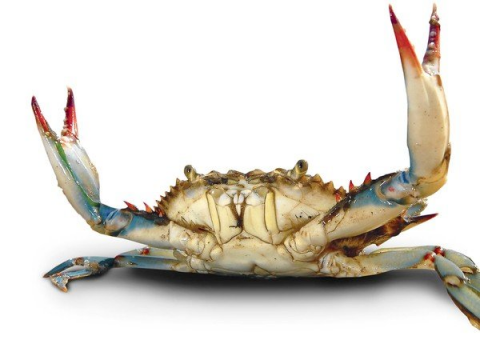 For centuries, the Chesapeake Bay has been a natural seafood factory along the East Coast, and that wealth of marine resources has shaped the area’s food culture and history—a 2011 Garden & Gun article referred to Maryland crab cakes as “practically a religion.” Seafood production also represents a critical portion of the Chesapeake Bay’s economic backbone. Read the rest here 10:17
For centuries, the Chesapeake Bay has been a natural seafood factory along the East Coast, and that wealth of marine resources has shaped the area’s food culture and history—a 2011 Garden & Gun article referred to Maryland crab cakes as “practically a religion.” Seafood production also represents a critical portion of the Chesapeake Bay’s economic backbone. Read the rest here 10:17Dead menhaden reported in Chesapeake Bay leads to Inquisition by Sport Fishers, explanation by VRMC

Oysters in the Chesapeake Bay: When Partnerships Work
Too often, environmental groups, regulators and fishermen find themselves cast in antagonistic roles on marine issues. Prolonged legal and regulatory battles frequently top headlines, while successful conservation partnerships go unheralded. The Chesapeake Bay, long plagued by problems like pollution and runoff, is benefitting from one such partnership. Read more here 11:10
Blue and Flathead Catfish Invade the Chesapeake Bay – No wonder prefered stocks are in trouble!
 Initially introduced for sport fishing in several Virginia tributaries in the 1960s to 1980s, blue and flathead catfish are now considered invasive in the Chesapeake Bay have , and they are now present in every major Chesapeake Bay tributary. Read more here 11:36
Initially introduced for sport fishing in several Virginia tributaries in the 1960s to 1980s, blue and flathead catfish are now considered invasive in the Chesapeake Bay have , and they are now present in every major Chesapeake Bay tributary. Read more here 11:36
Watermen report Chesapeake blue crab shortage – Video
 Blue crabs are big business along the Chesapeake Bay during the summer months. They’re a Virginia tradition — steamed, deviled, or battered up and fried, blue crabs are in high demand for miles around. But this year, they’re in short supply. Read more here 08:49
Blue crabs are big business along the Chesapeake Bay during the summer months. They’re a Virginia tradition — steamed, deviled, or battered up and fried, blue crabs are in high demand for miles around. But this year, they’re in short supply. Read more here 08:49
Gov. McAuliffe Celebrates Signing of New Chesapeake Bay Watershed Agreement
 The Agreement, developed over the last two years, lays out clear goals and outcomes for sustainable fisheries, vital habitats, water quality, toxic contaminants, healthy watersheds, stewardship, land conservation, public access, environmental literacy, and resiliency of the Bay ecosystem in the face of changing climatic conditions and rising sea levels. Read more here 18:44
The Agreement, developed over the last two years, lays out clear goals and outcomes for sustainable fisheries, vital habitats, water quality, toxic contaminants, healthy watersheds, stewardship, land conservation, public access, environmental literacy, and resiliency of the Bay ecosystem in the face of changing climatic conditions and rising sea levels. Read more here 18:44
Study Finds Reduction in Pollution in Chesapeake Bay
A new report says the states in the Chesapeake Bay’s watershed are making progress in reducing pollution, but fall short in preventing runoff from urban, suburban and farming sources. Read more here 06:52
McAuliffe signs storm-water legislation at VIMS
 GLOUCESTER Va— Gov. Terry McAuliffe proved he’s a hands-on governor Thursday when he capped a ceremonial signing of state legislation regulating storm water on the campus of Virginia Institute of Marine Science with a tour on a trawling boat that had him handling live fish and blue crab. Read more here 09:18
GLOUCESTER Va— Gov. Terry McAuliffe proved he’s a hands-on governor Thursday when he capped a ceremonial signing of state legislation regulating storm water on the campus of Virginia Institute of Marine Science with a tour on a trawling boat that had him handling live fish and blue crab. Read more here 09:18
O’Malley has failed to protect the Chesapeake Bay [Letter]
In his recent State of the State Address, Gov. Martin O’Malley touted his accomplishments in Chesapeake Bay restoration. On closer examination, the record reveals that his claims were misstatements, at best. Robert Lyon, Annapolis Read more here 15:43
Chesapeake Bay Makes Progress, But Still Hindered By Illegal Discharge
EIP Attorney Tarah Heinzen said: “2012 progress reducing industrial and municipal pollution in key Chesapeake Bay states is encouraging, but we need to do more if we want to stay on track and meet 2017 goals. Nitrogen, phosphorus, and sediment pollution continues to degrade the water quality and fisheries of the Chesapeake Bay and its tributaries each year. All of the Bay states must focus on reducing these discharges and get serious about stopping illegal discharges.” Read more@pollutiononline 06:37
Holiday season is time to crack down on oyster poaching in Chesapeake Bay
 The weeks leading to the holidays tend to be the most active for oyster poachers in the Chesapeake Bay, but the Maryland Department of Natural Resources and state police were hoping in recent days that new technology and harsher penalties would help them crack down on illegal oyster harvesting. Read more@baltimoresun 13:10
The weeks leading to the holidays tend to be the most active for oyster poachers in the Chesapeake Bay, but the Maryland Department of Natural Resources and state police were hoping in recent days that new technology and harsher penalties would help them crack down on illegal oyster harvesting. Read more@baltimoresun 13:10

































